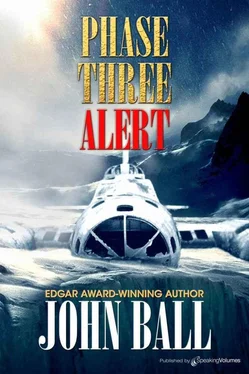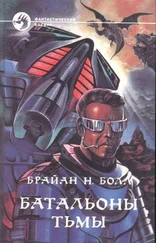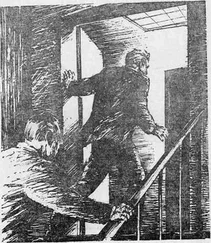At that point Stovers stopped everything while he checked still one more time to be sure that no mistake had been made. As he did so, a dozen men spread a snow blanket on the deck of the cargo hold to serve as a sliding base.
What had been slow before now became cautious to the point of exasperation; the tug moved only on signal from Stovers and then only inches at a time. Ferguson could not stand to watch it any longer, and there was nothing he could do. He continued to search the sky and to listen. He glanced at the portable beacon that Sergeant Murphy had put into operation and then focused his eyes toward the distant horizon once more. He saw a tiny black speck approaching in the sky.
He could have yelled for joy, but instead he stood still and watched the speck grow until he could catch the movement of its main rotor. It was approaching rapidly and presently he could detect the sound of its engines. Hardly a minute later the big Sikorsky arrived overhead, hovered for a moment, and then settled down onto the snow.
Major Kimsey emerged in his arctic clothing to find Ferguson waiting to greet him. “We made our fuel drop without incident,” the major reported. “How are you making out?”
“This is the hardest load,” Ferguson answered, “but we’re well along with the job.”
“It looks that way. A pretty tight fit.”
“We’re having to put it in on an angle; we can just make it that way. Stovers knows his business.”
“How about a look at those wing sections,” the major said. He gathered the rest of his crew and the two Det. 4 pilots who had flown out on the C-130, and then walked over to the nearest of the two massive components. There was no denying its size.
“It looks awfully heavy to us,” Lieutenant Seligman ventured.
The major walked around it, peered inside at the open ends, and measured it by visual inspection. “All right,” he said finally, “we’ll take on some fuel and then give it a try. It’s so big it’s going to be aerodynamic anyway, so we might as well rig the sling so that the leading edge will be forward. In that way, it can take a good deal of the load off the rotor system. It’s a little risky, but the sling will act as a partial spoiler and we can’t go very fast with that thing to haul in any event.”
“In other words, the wing section will fly itself,” Heneveld commented.
“If we do everything right, yes.”
There were enough men to spare to help with the rigging of the sling, but it was still rigorous work. It took a full half hour to get it adjusted to the major’s satisfaction. They were still hard at it when the second helicopter arrived overhead and settled down close to the C-130.
By the time the fuel had been transferred, the tip of the nose of the still-frozen bomber was disappearing inside the turboprop airlifter. The moment of truth was at hand. The crew of Major Kimsey’s HH-3 fired up their bird and shortly thereafter lifted off. As its main rotor blasted air downward in a small gale, the rescue Jolly maneuvered over the wing section and two of the Det. 4 men attached the sling from underneath. Ferguson held his breath; this was it and the next few seconds would decide.
The engines of the hovering helicopter surged, the rotor seemed to spin even faster as the lines came tight. For five long seconds there was no visible movement, then, almost as if it were easy, the Jolly Green Giant picked up the cumbersome wing section, turned, and began to move away.
Ferguson watched, hypnotized, as the helicopter climbed some two hundred feet, its massive load dangling below it, and then started to head back toward Thule.
As though it had been a touchdown in a traditional high school football game, there was a spontaneous cheer. At that moment everyone knew that all of the work that had so far gone into the recovery of the ancient four-engined bomber was viable. Ferguson turned to help as much as he could with the refueling of the second helicopter. The tug crossed the snow bridge for the last time and stopped on the loading ramp of the airlifter.
While the fuel was being metered, willing hands rigged the second sling around the remaining wing section under the careful direction of a Det. 4 flight mechanic. In much less time than it had taken previously, Major Mulder found everything ready to his satisfaction. The Jolly he commanded was airborne within five minutes and the second pickup went off perfectly. As the powerful helicopter beat its way higher into the sky, with the last component of the B-17 suspended underneath, Ferguson turned for one last time and surveyed the ice cap where the World War II bomber had stood in deadly isolation for thirty long years. Only the trampled and scraped snow marked the spot where the abandoned airplane had been; there was nothing whatever left. And there was no reason to ever return to this place again.
He turned and almost ran back to his own aircraft. “Let’s get the hell out of here!” he shouted.
With a glorious euphoria he stripped off his arctic gloves, his mittens and liners, shed his parka, and climbed into his left-hand seat. Corbin was ready to begin the precise business of the checklist. When he came to “Cabin report,” Sergeant Stovers responded on the intercom.
“All pax, cargo, and gear secured. Cabin ready.”
Ferguson double-checked the indicator on the panel that showed the rear ramp to be closed and sealed; the confirmation sent a wave of satisfaction through his body.
In sequential order the four engines of the Hercules came to life; the props cut their great discs in the air. Corbin announced, “Checklist complete.”
Ferguson altered the pitch and the C-130 responded by sliding forward on its skis. He added more power as he turned onto the marked runway and began his takeoff. He watched the speed grow with primitive delight; the snow rushed backward faster and faster until Corbin called, “Rotate.” Ferguson pulled back on the yoke — the nose of the Hercules rose and she came off the ice into the air where she belonged, carrying the massive nose section of the B-17 in her hold.
Within four minutes silence returned to the place the airlifter had left. Within a few days the winds would erase every trace of what had once been there. The only clue that remained was the four runway markers. Perhaps in years to come some pilot might spot them from the air and wonder for what conceivable reason they had been set out in such a totally remote region. And if, perhaps, someone were to guess that the ice cap concealed some sort of frozen buried treasure, and went searching for it with some as yet unimagined sounding device, there would be nothing whatever for him to find.
Ferguson turned to Corbin. “Do you want to bring her home, Red?” he asked.
The long-suffering copilot was more than ready and prepared; he took over the controls without delay. When he was close enough to Thule, he set up an instrument approach in wide-open weather, came down the glide path with ground radar assistance, and flared onto the runway with such precision that he wished he could have saved that landing to frame and hang on the wall of his room.
The tower directed them to Hangar 8 without being asked. As the C-130 taxied onto her designated spot she had company: a mighty C-141 jet airlifter was parked in front of number seven. “More stuff for the Army,” Corbin commented as Ferguson slowly turned in response to the signals from the ramp man. When he received the hand across the throat signal, he hit the brakes and then went into the cockpit securing routine. Now if the colonel wanted to order him not to make any more nonessential flights out over the ice cap, he could go right ahead — the job had been done.
All that remained to be sure was the arrival of the wing root sections. He had a foreboding that they actually weighed much more than Holcomb had estimated. Until those sections were in, nothing was certain.
Читать дальше












